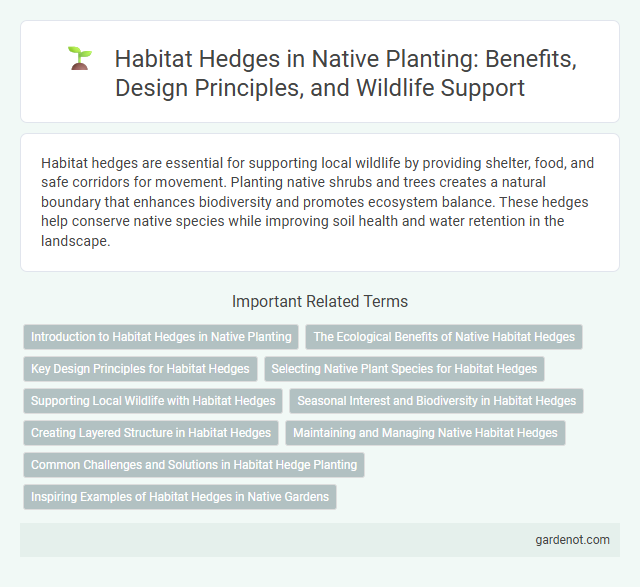Habitat hedges are essential for supporting local wildlife by providing shelter, food, and safe corridors for movement. Planting native shrubs and trees creates a natural boundary that enhances biodiversity and promotes ecosystem balance. These hedges help conserve native species while improving soil health and water retention in the landscape.
Introduction to Habitat Hedges in Native Planting
Habitat hedges are strategic plantings of native shrubs and trees designed to support local wildlife by providing food, shelter, and nesting sites. These hedges enhance biodiversity by creating corridors that connect fragmented habitats, allowing species to thrive and migrate safely. Incorporating habitat hedges in native planting promotes ecological balance and sustains pollinators, birds, and small mammals essential to healthy ecosystems.
The Ecological Benefits of Native Habitat Hedges
Native habitat hedges provide essential ecological benefits by supporting local biodiversity and creating habitats for pollinators, birds, and small mammals. These hedges improve soil health through natural nitrogen fixation and enhance water retention, reducing erosion and runoff. By using native plant species, habitat hedges contribute to ecosystem resilience and help maintain regional ecological balance.
Key Design Principles for Habitat Hedges
Habitat hedges are designed with native plant species to support local biodiversity and provide shelter for wildlife. Key design principles include selecting diverse, multi-layered vegetation that mimics natural habitats, incorporating flowering and fruiting plants to offer food resources, and planning for structural complexity to enhance ecological functionality. Proper spacing and maintenance ensure healthy growth and long-term habitat value.
Selecting Native Plant Species for Habitat Hedges
Choosing native plant species for habitat hedges enhances local biodiversity by providing essential food and shelter for native wildlife. Selecting a mix of native shrubs, trees, and groundcovers ensures year-round habitat complexity and supports pollinators, birds, and small mammals. Prioritize species adapted to the local climate and soil conditions to promote healthy growth and ecological balance.
Supporting Local Wildlife with Habitat Hedges
Habitat hedges provide essential shelter and food resources for local wildlife, promoting biodiversity and ecosystem health. Native plants in these hedges support pollinators such as bees and butterflies, while offering nesting sites for birds and small mammals. Strategic planting of habitat hedges enhances natural corridors, allowing species to thrive and maintain ecological balance.
Seasonal Interest and Biodiversity in Habitat Hedges
Habitat hedges enhance seasonal interest by featuring diverse native plants that showcase varying blooms, foliage colors, and textures throughout the year. These hedges support biodiversity by providing essential shelter and food sources for pollinators, birds, and small mammals. Integrating multiple native species in habitat hedges creates dynamic ecosystems that change with the seasons, promoting ecological balance and resilience.
Creating Layered Structure in Habitat Hedges
Creating a layered structure in habitat hedges enhances biodiversity by incorporating a mix of native canopy trees, understory shrubs, and groundcovers. This stratification provides varied habitats for wildlife, improves soil health, and supports pollinators throughout different vertical levels. Selecting native species such as elderberry, serviceberry, and native grasses promotes ecological resilience and sustains local ecosystems effectively.
Maintaining and Managing Native Habitat Hedges
Maintaining native habitat hedges requires regular monitoring for invasive species and ensuring diverse native plant regeneration to support local wildlife. Pruning should be minimal and carefully timed to preserve nesting sites and food sources for birds and pollinators. Proper management also involves soil health assessment and supplemental planting to enhance hedge resilience and ecological function.
Common Challenges and Solutions in Habitat Hedge Planting
Habitat hedge planting often faces challenges such as poor soil quality, invasive species competition, and limited native plant availability. Addressing these issues involves improving soil conditions through organic amendments, implementing regular invasive species control, and sourcing plants from reputable native nurseries. Successful habitat hedges also benefit from strategic species selection that supports local wildlife and enhances ecosystem resilience.
Inspiring Examples of Habitat Hedges in Native Gardens
Habitat hedges in native gardens provide essential shelter and food sources for local wildlife, creating thriving ecosystems. Examples like the Pacific Northwest's mixed-species hedgerows featuring salal, ocean spray, and red-flowering currant demonstrate how biodiversity supports pollinators and birds. These native plant combinations enhance ecological resilience while adding natural beauty to garden landscapes.
Habitat hedge Infographic

 gardenot.com
gardenot.com